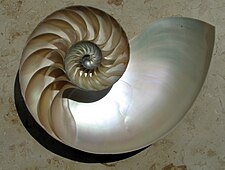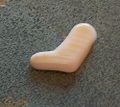Difference between revisions of "AY Honors/Shells - Advanced/Answer Key"
(No difference)
|
Revision as of 22:38, 12 October 2006
Template:Dablink Nacre, also known as mother of pearl, is a naturally-occurring organic-inorganic composite.

Description
Nacre is composed of hexagonal platelets of aragonite (calcium carbonate (CaCO3) crystals) that are 10-20 µm wide and 0.5 µm thick, arranged in a continuous parallel lamina. The layers of platelets are separated by sheets of organic matrix that are composed of elastic biopolymers (such as chitin, lustrin and silk-like proteins). This mixture of brittle platelets and the thin layers of elastic biopolymers makes the material strong and resilient. Strength and resilience are also likely to be due to adhesion by the "brickwork" arrangement of the platelets, which inhibits transverse crack propagation. This design at multiple-length sizes increases its toughness enormously, making it almost equivalent to that of silicon.
The iridescent appearance of the nacre is due to the fact that the thickness of the aragonite platelets are about 0.5 micrometres, which is comparable to the wavelength of visible light. This results in constructive and destructive interference of different wavelengths of light, resulting in different colors of light being reflected at different viewing angles.
Nacre is secreted by the epithelial cells of the mantle tissue of certain species of mollusk. In these mollusks, nacre is continually deposited onto the inner surface of the animal's shell (the iridescent nacreous layer, commonly known as mother of pearl), both as a means to smooth the shell itself and as a defense against parasitic organisms and damaging detritus.
The iridescent inner layer is considered highly attractive by many cultures and is often used in making jewelery or as inlays in wood furniture and guitars.
When a mollusk is invaded by a parasite or is irritated by a foreign object that the animal cannot eject, a process known as encystation entombs the offending entity in successive, concentric layers of nacre. This process eventually forms what we call pearls and continues for as long as the mollusk lives.
Chief sources are the pearl oyster, found in warm and tropical seas, primarily in Asia; freshwater pearl mussels, which live in many rivers of the United States, Europe, and Asia; and the abalone of California, Japan, and other Pacific regions.
Nacre is composed of a hexagonal platelets of aragonite (calcium carbonate (CaCO3) crystals) that are 10-20 µm wide and 0.5 µm thick, arranged in a continuous parallel lamina. The layers of platelets are separated by sheets of organic matrix that are composed of elastic biopolymers (such as chitin, lustrin and silk-like proteins). This mixture of brittle platelets and the thin layers of elastic biopolymers makes the material strong and resilient. Strength and resilience are also likely to be due to adhesion by the "brickwork" arrangement of the platelets, which inhibits transverse crack propagation. This design at multiple-length sizes increases its toughness enormously, making it almost equivalent to that of silicon.
The iridescent appearance of the nacre is due to the fact that the thickness of the aragonite platelets are about 0.5 micrometres, which is comparable to the wavelength of visible light. This results in constructive and destructive interference of different wavelengths of light, resulting in different colors of light being reflected at different viewing angles.
Nacre is secreted by the epithelial cells of the mantle tissue of certain species of mollusk. In these mollusks, nacre is continually deposited onto the inner surface of the animal's shell (the iridescent nacreous layer, commonly known as mother of pearl), both as a means to smooth the shell itself and as a defense against parasitic organisms and damaging detritus.
The iridescent inner layer is considered highly attractive by many cultures and is often used in making jewelery or as inlays in wood furniture and guitars.
When a mollusk is invaded by a parasite or is irritated by a foreign object that the animal cannot eject, a process known as encystation entombs the offending entity in successive, concentric layers of nacre. This process eventually forms what we call pearls and continues for as long as the mollusk lives.
Chief sources are the pearl oyster, found in warm and tropical seas, primarily in Asia; freshwater pearl mussels, which live in many rivers of the United States, Europe, and Asia; and the abalone of California, Japan, and other Pacific regions.
Gallery
- HoloscaphitesAmmonite.jpg
Fossilized Ammonite with nacre shell intact
References
- Lin, A., and Meyers, M.A. (2005). Growth and structure in abalone shell, Materials Science and Engineering A 390(Jan. 15):27–41 ([1])
- Mayer, G. (2005). Rigid biological systems as models for synthetic composites. Science 310:1144–1147
- Template:Cite journal pdf file on line
See also
de:Perlmutt es:Nácar fr:Nacre nl:Parelmoer pl:Masa perłowa pt:Madrepérola sv:Pärlemor tr:Sedef vi:Xà cừ (vật liệu)


